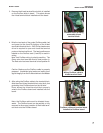
5.1 COMMUNICATIONS ARCHITECTURE- OVERVIEW
The PROFIBUS-DP communications profile specifies the operating characteristics of a serial fieldbus intended
for the interconnection of distributed digital devices at the field level. To achieve this, PROFIBUS designates
these devices as either masters or slaves:
• Masters, or active stations, control the transmission of data around the bus. A master may transmit messages
freely although, sometimes, it may have to obtain network access rights (in the case of multi-master applications
using tokenpassing).
• Slaves, or passive stations, are distributed devices (I/O devices, valves, instrumentation transmitters, etc.)
that do not have bus access rights without authorization. Their operation is limited to acknowledging messages
received or transmitting messages at the request of a master device. In order to route data to its destination
address, or to tell the destination address how to handle the data received, a formal set of rules and conventions
for the exchange of data signals is required.
The International Standards Organization (ISO) uses an outline model referred to as the Open Systems
Interconnection (OSI) reference model. This reference model defines 7 levels used in the transfer of data. These
levels are referred to as layers. PROFIBUS-DP operates on the two lowest levels, layer 1 (physical connections)
and layer 2 (data links). Layers 3 to 7 are unused in this profile.
5.2 DATA TRANSMISSION
PROFIBUS-DP is designed for efficient communication between programmable logic controllers (PLCs), industrial
PCs (IPCs), etc., and distributed peripheral devices such as I/O devices, drives, valves, and measurement sen-
sors, etc. Most data exchanges are carried out in a cyclic fashion. The communication functions required are spec-
ified by the basic PROFIBUS-DP communications profile, in accordance with the European harmonized standard,
EN 50170.
5.3 DEVICE DATABASE FILE (GSD FILE)
PROFIBUS devices may be defined in terms of their performance and their available functions, e.g. the number
of I/O signals and diagnostic messages, and their bus settings, such as transmission speeds or time monitoring.
These settings will vary with the equipment type and manufacturer but they are usually defined in the manufac-
turer's documentation.
To simplify PROFIBUS configuration or even make it transparent to the user, this data is collected together into a
single computer file, sometimes referred to as a device data base file or, more often, a GSD file.
GSD files provide a clear and complete description of a device's properties. The Model 1056 device has its own
GSD file.
Model 1056 GSD files may be downloaded free from the GSD library on the web server at:
http://www.emersonprocess.com/raihome/liquid/products/AMS_FIELDBUS.asp
13
MODEL 1056DP SECTION 5.0
DEVICE CONNECTION TO PROFIBUS NETWORK
SECTION 5.0
DEVICE CONNECTION TO PROFIBUS NETWORK
5.1 COMMUNICATIONS ARCHITECTURE- OVERVIEW
5.2 DATA TRANSMISSION
5.3 DEVICE DATABASE FILE (GSD FILE)


















